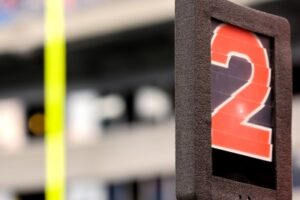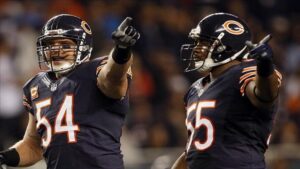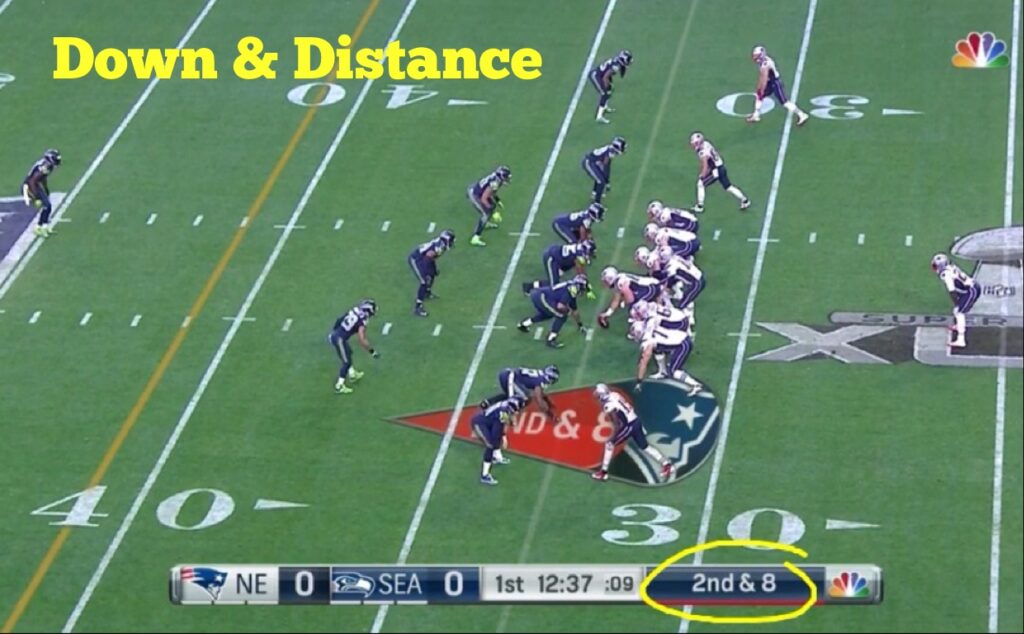How Down & Distance Tendencies are Used by NFL Defenses
In 1999, I entered my first professional football meeting room in Earth City, Missouri, eagerly taking in the sight of the impressive training facility, wide-eyed like a newborn.
Coming from a Division II program at the University of South Dakota, I knew I was in for a stark contrast in facilities.
Of course, there was a sense of wonder in meeting the other St. Louis Rams players, those familiar NFL faces I’d only seen on TV from a distance.
It was especially exciting for someone like me, aspiring to be among them.
However, the most significant adjustment to becoming a professional football player wasn’t the state-of-the-art facilities or the presence of fellow athletes.
It was the game itself. Despite considering myself a devoted “student of the game” – a lifelong football enthusiast and film aficionado during my high school and college years – I quickly realized there was a whole new level of understanding required.
Even with my background as a pre-law student in college, juggling two majors and maintaining an impressive GPA, I found out that intelligence alone wasn’t enough in this demanding field.

I entered the room with confidence, thinking I had a solid grasp of football. However, after that initial defensive meeting, I walked out with the stark realization that I was clueless.
Navigating the NFL is like tackling graduate-level material.
While NFL Rewind has opened up football film to a wider audience, there’s been an abundance of superficial analysis, often reduced to mere tracing of player movements.
Unfortunately, this approach doesn’t lead to a deeper understanding of professional game film.
Any player with significant experience in an NFL offense or defense will attest to the fact that inaccurate information can be far more detrimental than having none at all.
My rookie NFL experience was a wake-up call to the level of expertise required in this game.
Throughout this NFL offseason, FBF’s “Inside the Game” will be a regular feature, delving into the intricacies of what truly transpires in those game films.
Reading an Offense’s Tea Leaves
Deciphering an NFL offense is akin to playing a game of “Where’s Waldo?”.
There’s an abundance of information available before the snap, with both sides vying to obscure or mislead the other.
While some of the information is straightforward, other elements are strategically placed to either divert attention or create false impressions that won’t hold true after the snap.
The key for a defensive player isn’t processing all the pre-snap data but rather pinpointing the most crucial piece and leveraging it to their advantage – that’s half the battle.
In NFL defense, being aware is paramount; it’s a mental challenge as much as a physical one.
A defense without a clear understanding is bound to struggle.
In the lower levels of the game, you might get by just by lining up and reacting to what you see, attempting to make a play.

In the NFL, failing to gain a mental edge can result in being a step behind, given the breakneck pace of the game.
It’s crucial to understand that the on-field perspective differs vastly from what you see on a computer screen.
Even with two decades of organized football experience, I find myself continually reminding myself of this as I watch the game from a distance.
It’s easy to misinterpret a player as being physically outmatched when, in reality, they may have simply misread the situation.
Conversely, you might perceive one player as overpowering another when it was actually a mental advantage that gave them the edge on the play.
On a level playing field, the seemingly ‘stronger’ or ‘more physical’ player may have just been quicker to react.
The read is the linchpin of everything you witness, a detail often overlooked from an outsider’s perspective…
In this column series, I’ll delve into the Big Three aspects of pre-snap information:
- Down & Distance
- Offensive Personnel
- Formation
For each of these columns, I’ll dissect a single play from the Super Bowl to shed light on some fundamental considerations when reading an offense from a defensive player’s standpoint.
This is the foundational information every defensive player on the field will be on the lookout for, but it holds special importance for the linebackers and safeties.
They serve as the communicators, adapting to the formations and relaying vital information to the defensive linemen and cornerbacks, who may not have as clear a view of the entire picture.
Down & Distance
Understanding D&D may seem like a given, as it’s a staple mentioned by most TV and radio play-by-play commentators before every play.
However, for a player, it’s not just about being aware of the game situation; it also serves as a clue regarding the potential play (or at least the type of play) that the offense may be planning.
In football, analytics find less practical application compared to other major sports.
Nevertheless, their use in football does hold value and is not a recent development by any means.
The challenge lies in sifting through the extensive data and extracting actionable insights due to the game’s inherent complexity.
Conclusions drawn from unfiltered football statistics often ring hollow.
Where statistical analysis truly shines in football is in identifying tendencies.
Each player receives advanced scouting reports as part of their weekly game preparation, offering an overarching view of what the opponent has done (and might do).
The crucial aspect is that teams must sift through this wealth of information on a weekly basis, discerning what is pertinent to their specific situation.
Often, what an opponent ran against a team with a completely different scheme and personnel may prove to be irrelevant.

Down and distance serve as a crucial filtering mechanism, allowing players and coaches to transform raw data into actionable insights.
For instance, as a player, you might learn in practice that the opponent heavily favors passing, with a ratio of 75/25 in favor of aerial plays over running. However, this is just the starting point.
The next step involves assessing whether these percentages hold true against a similar opponent. If they differ significantly in style or strategy, those numbers may not hold much weight.
Another important aspect is considering if external factors, such as game situations, may have skewed the statistics in one direction or another.
Lastly, it’s vital to evaluate if the team has been successful at those rates.
If not, there may be a strong motivation to alter their play-calling in the future.
Once all the extraneous data that doesn’t pertain to your specific situation is discarded, you’re left with the essential information to work with.
However, it’s important to acknowledge that sometimes, based solely on down and distance, you may not have enough to form a comprehensive understanding.
Assuming the remaining relevant information constitutes a sizable and credible sample, you can then begin to identify a few D&D tendencies to focus on for the week.
For a player, it can’t be stressed enough how critical both relevance and sample size are in attempting to gain insights into an opposing offense.
If a coach or film study leads a player to believe that the other team leans heavily towards a certain play or strategy on a specific D&D, that “fact” can quickly lose its value if it’s actually closer to a 50/50 split against teams employing a similar approach.
Even worse is when that 75% statistic is derived from just three out of four plays early in the season, and after a couple of plays that deviate from the trend, there’s no discernible tendency at all.

This marks New England’s inaugural offensive series of the game, with the initial play yielding a mere two yards.
In the NFL, for the purpose of statistical tracking, 2nd & 8+ is a commonly used filter as it signifies a suboptimal outcome – falling short of the desired 3 yards needed to “stay on track.”
In high-stakes games like the Super Bowl, where a team has executed a significant number of offensive plays, a distinct tendency towards either running or passing to “get back on track” should have emerged.
As a defense, you would essentially analyze all the 2nd and 8+ plays that New England has executed throughout the year against teams employing a similar defensive scheme.
In the event that New England underwent a substantial personnel change, such as a key injury to a prominent running back or receiver, you would further refine the filter to ascertain what is currently most relevant (and likely).
If New England indeed displayed a notable tendency to opt for a pass to “get back on track” after this filter, as a defense, you would have taken the initial step in gaining valuable insight into the type of play to anticipate.
HOWEVER, THIS IS ONLY THE START. A down-and-distance tendency serves as an introduction.
It must then be cross-referenced with the personnel grouping and formation (topics we’ll delve into in Parts 2 & 3 of this column series).
The last thing a player wants is to rely on a down-and-distance tendency that was, in fact, nullified by a formation exhibiting a stronger (overriding) tendency.
Another critical aspect to consider when discussing D&D is whether any tendency holds true based on the field position.
For instance, a team might exhibit a strong passing tendency for 2nd & 8+, but only between the 20-yard lines.
When backed up (inside their own 20) or in the red zone (inside the defense’s 20), they may not lean towards passing at all in “get back on track” situations.
This serves as a valuable reminder of the importance of factoring in all relevant filters.
It’s akin to saying a particular island is sunny 88% of the time, which may hold true, but that “fact” is hardly of consequence if you’re visiting during hurricane season.
Additionally, it’s prudent to exercise caution when dealing with the “danger zone” of football tendencies.
A tendency may appear robust at first glance, say at 78%, but as field position changes, it might drop to 60%.
Sixty percent poses a risk for players because it’s not sufficiently strong to justify leaning heavily in one direction or the other.
In such cases, it’s best to set aside the tendency and approach the play more neutrally.
Personally, once a percentage dipped below 70%, I found it to be of limited use on the field.
“More often than not” isn’t substantial enough to warrant clouding your mind before a play. What you aim to identify are a few “most likely” scenarios and adhere to those.
Down and distance stands as the initial, fundamental nugget of information that defensive players wield to begin deciphering the impending moves of the offense.
Tomorrow, we’ll delve into how the subsequent layer of context – offensive personnel – is introduced to either reinforce or nullify any potential insights…

